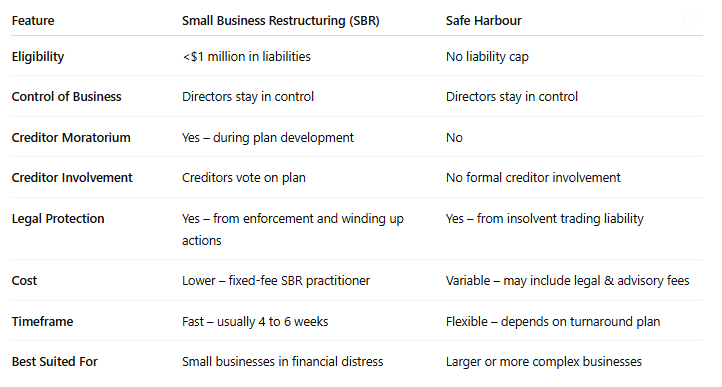Small Business Restructure vs Safe Harbour: What’s the Difference?
When a company begins to struggle financially, directors have several legal options to protect the business and themselves. Two commonly misunderstood but powerful mechanisms are Small Business Restructuring (SBR) and Safe Harbour. Both offer legal protection from insolvent trading, but they are designed for different business sizes, circumstances, and goals.
Below, we compare the two in detail to help directors and advisors make informed decisions.
What Is Small Business Restructuring (SBR)?
Introduced in 2021, the Small Business Restructuring framework allows eligible small businesses to formally propose a debt repayment plan to creditors—including the ATO—while the director retains control of day-to-day operations.
Key Features:
Eligibility: Company liabilities under $1 million
Director Control: Directors remain in control during the process
Creditor Protection: Moratorium on unsecured creditor enforcement
Outcome: Legally binding debt restructure with creditor approval
Support: Must engage a registered Small Business Restructuring Practitioner (SBRP)
What Is Safe Harbour?
Safe Harbour, introduced in 2017 under the Corporations Act, protects directors from personal liability for insolvent trading while they develop a turnaround plan—provided they meet certain criteria and act responsibly.
Key Features:
Eligibility: Any solvent or insolvent company (no $1M cap)
Director Control: Directors retain full control
Creditor Protection: No moratorium—creditors can still pursue action
Outcome: Informal restructuring with no creditor vote required
Support: Typically requires financial and legal advisors
Side-by-Side Comparison
Which Option Is Right for You?
Choose SBR if your company has total liabilities under $1 million and you need a structured, formal plan to deal with debts—especially tax debt.
Choose Safe Harbour if your company is larger or undergoing a complex turnaround that doesn’t need immediate creditor approval or ATO negotiation.
Real-World Example
A small plumbing company with $750,000 in ATO and trade debt used SBR to reduce debt by 65% while continuing to operate. The directors remained in charge, and creditors approved the plan in under 30 days.
Conversely, a mid-sized manufacturer facing short-term cashflow issues used Safe Harbour while negotiating with a bank and reworking internal operations—without any formal creditor involvement.
Legal Basis
Small Business Restructuring: Corporations Act 2001 (Pt 5.3B)
Safe Harbour: Corporations Act 2001, Section 588GA
Final Thoughts
Both Safe Harbour and SBR are legitimate tools to avoid liquidation and save a business, but they serve different needs.
If you're unsure which path to take, consult a licensed restructuring practitioner or insolvency advisor who understands your industry and financial position.
References:
Australian Securities & Investments Commission (ASIC)
https://asic.gov.auCorporations Act 2001 (Cth)
https://www.legislation.gov.auThe Treasury, Small Business Insolvency Reforms
https://treasury.gov.au

